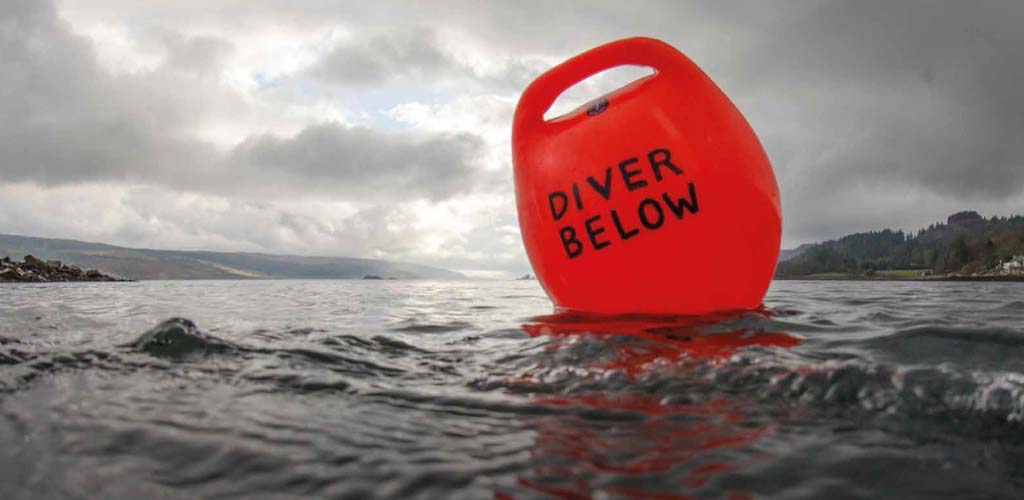
Be a blob, not a blimp, says Chris Hine of Perth BSAC and the South Scotland regional team, who reports on a recent Buoyancy and Trim Workshop.
Good buoyancy will greatly increase your enjoyment of diving, but this is a skill that you learn and not one that comes naturally to many divers. After all, we evolved to walk with our feet firmly anchored to the ground by gravity and not to float around freely in three dimensions. My personal observation suggests there are two types of divers: the blobs, who can just hang in mid water to the envy of others; an then the blimps, the divers that need forward momentum to maintain their in-water position.
To some divers, buoyancy control comes easier than to others but we all, at some stage in our training, learn that adding air to and dumping it from a buoyancy device makes you go up and down in the water column. Hopefully at some point it becomes second nature.
It is important to master this basic skill but why can it, at first attempt, seem so difficult? The BSAC Diver Training Programme (DTP) places great emphasis on buoyancy training, achieving neutral buoyancy is practised throughout the early phases, adding and dumping gas endlessly, and it is assumed that by the time you become a Sports Diver you are both competent and confident at so doing. But are you? Next time you are in the water try to hold a given depth, no finning and no excessive breathing, just hanging in the water column. How did you get on? What was your horizontal position, your trim, like? Want to make it easy? Choose a reference point, a sea urchin on a reef, and watch it and all of a sudden you understand why photographers need such good buoyancy skills.
With good buoyancy you are no longer fighting against the environment you find yourself in, you are a part of it, you stop landing on the bottom raising clouds of silt or damaging the precious wildlife, and you become more aware of your environment, the subtle changes in pressure caused by up and down currents, which can carry you around obstructions rather that into them.
You no longer have to incessantly add and dump air from your buoyancy compensator or drysuit and you start to relax. With that, your in-water time, and enjoyment of it, increases. With good buoyancy skills, your safety increases as well. I’m not talking about performing decompression stops or avoiding uncontrolled ascents or descents, but the ability to resolve other minor issues that can rapidly evolve into an incident pit scenario. Simply put, if you are neutrally buoyant you have the chance to resolve any problems without having to deal with a rapid ascent at the same time.
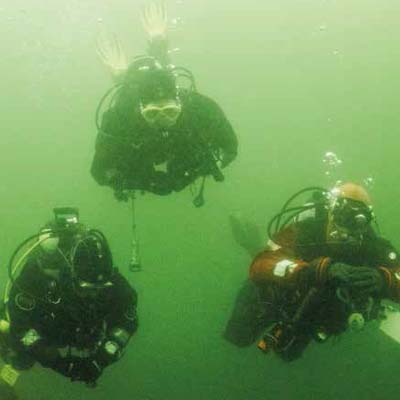
Buoyancy and Trim Workshop
The Buoyancy and Trim Workshop is a Skill Development Course (SDC) that provides an opportunity to practise buoyancy control; it gives both an impartial critique of your skill levels and more importantly a few ideas on how to improve. The workshop contains a theory session that provides understanding of what affects buoyancy and trim and then a practical session where you put into practice what you have discussed, testing yourself to see how good you actually are. It should not merely be a tick-in-the box exercise, as the workshop provides skills and sets out achievement targets that you can take away and hone on future dives and, if you want to, you can come back at a later date to try for your next badge.
Course report: South Scotland workshop
When you arrive at any regional event it is a good idea to make yourself known by registering and introducing yourself to your instructor. Most instructors are genuinely interested in who you are, and what you’ve been doing, which provides an understanding of your experience and your recent dive history. It also provides the chance to talk about your kit and any changes to its configuration you have made and want to try out for the first time. I always tell people I’ve washed my socks, which allows me to introduce a discussion on the effect of undergarments and thermal layers; a frequently overlooked cause of buoyancy problems and a good way to break the ice before getting to grips with the theory lessons.
The theory session covers the physics of buoyancy and symptoms associated with some common problems as well as simple mechanics related to centre of gravity. This doesn’t take too long and then you’re off outside to have a dry practical session looking at kit configuration and the effect small changes to this can make.
A common issue that affects trim in drysuit divers, for example, is integral weight pockets. For a tall diver you can find that integral weight pockets end up above your centre of gravity, resulting in a head down trim. Buying ankle weights to counter this is not the best solution; a good old-fashioned weightbelt or weight harness might have been a better purchase, or indeed simply moving your cylinder further down your back would help. Small or short divers using a dumpy cylinder can experience the same problem and you need to have a similar discussion. But to be honest unless you attach the cylinder into the BC at its shoulder, ankle weights do seem a good solution here. 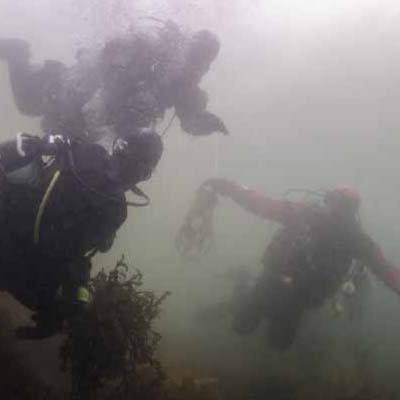 Soon enough it’s time to go diving and invariably any problems with weighting come to light. This is not usually because people are inappropriately weighted, after all they are qualified divers, but because all that kit is bone dry and super buoyant and air takes time to migrate through the suit to dump valves. Patience is the key; bobbing around on the surface for a few minutes chilling out before descending is a good trick, as is lifting your arms to start the descent. What often happens is that people get their head a foot under water then take a big breath and bob back up… it’s time to relax.
Soon enough it’s time to go diving and invariably any problems with weighting come to light. This is not usually because people are inappropriately weighted, after all they are qualified divers, but because all that kit is bone dry and super buoyant and air takes time to migrate through the suit to dump valves. Patience is the key; bobbing around on the surface for a few minutes chilling out before descending is a good trick, as is lifting your arms to start the descent. What often happens is that people get their head a foot under water then take a big breath and bob back up… it’s time to relax.
With the appropriate weighting, the next skill to practise is anticipation, how to stop the descent so we do not end up bouncing off the bottom and stirring up all the silt. A stop on the way down is a good idea, or perhaps knowing that there is a rock shelf on which to settle down and do our in-water checks. I find that most students are a bit wound up on the first dive so yo-yo-ing up and down is quite normal until they get into their stride and realise we are just diving.
The rest of the lesson is all about practising; going up and down, finding a point of reference and holding a stop, and finding reference points at different depths. This session is really useful for the course instructors as they get the chance to identify areas for improvement in their students while demonstrating different finning techniques, diving head up and head down and making minor adjustments using your arms; challenging the art of the possible.
Achieving horizontal trim is challenging, as most people start off oriented like a seahorse before really thinking about it, moving to the horizontal and minimising their drag. It is very difficult to convince people they are not seahorses! Mind you, diving head up does stop you swimming into things. By now most students have relaxed and have started to enjoy the dive, but all too quickly it is over and it is time to make our way back to shore.
The debrief brings a personal critique, most importantly with some ideas about how you can do this, and then it is time for a break.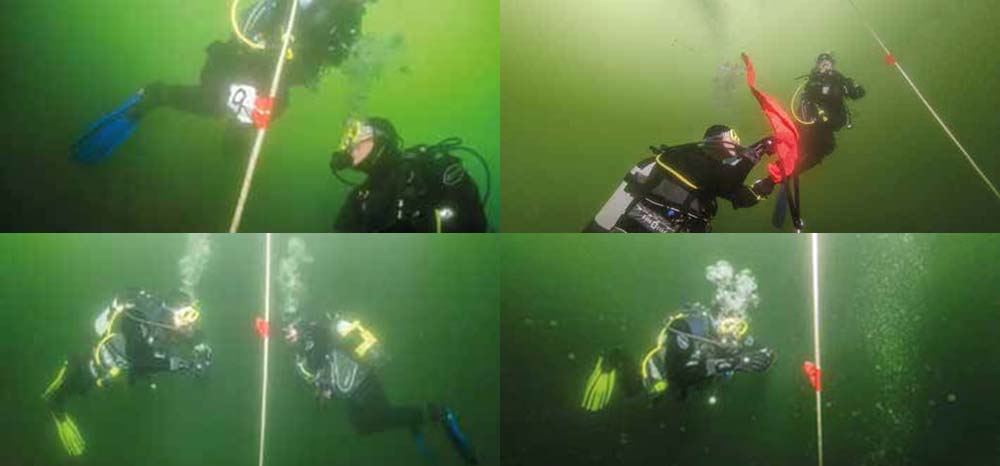
The second dive is an assessment and gives the students a chance to see how they do when holding stops on a shot line marked at a variety of depths. The trick here is to get settled before you start the assessment, get your buoyancy right before the instructor starts his stopwatch and just relax. If you are doing very well then you may be asked to do something while holding your stop, clear your mask, swap to your alternative supply or deploy a delayed surface-marker buoy, it’s not to make you fail, it’s just to task-load you to provide an extra challenge.
With all stops completed it’s time to swim back and get a final debrief where the instructor goes through the exercise, tells you where you did really well, provides advice on where and how you can improve and suggests how to incorporate the skills in your future diving.
Games we play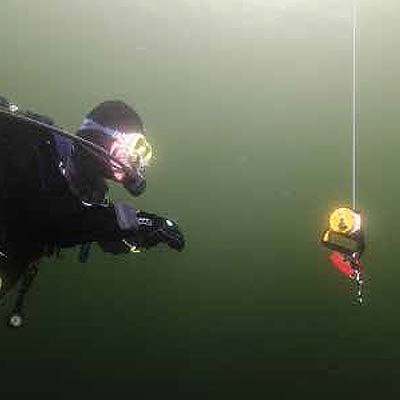
Buoyancy is a skill and, as I said before, for some people it comes naturally; for others, including me, it has to be worked on. I like the idea of games and if I can incorporate them in my training I do so enthusiastically. In the training pool I use the tiles to see if I am maintaining a constant hover, and on a dive I’ll use a shot line to the same effect while I complete my decompression. When I use a dSMB, I frequently deploy it and when it is safe to do so let it hang in the water column and then without touching it use it as a reference to gauge my buoyancy against. It’s fun and whiles away the time.
Further information: Buoyancy and Trim Workshops
The South Scotland Regional event was hosted by Fyne Divers as part of the BSAC South Scotland region’s support for the Diver Training Programme.
Thanks to Quarry View Garden Centre and Coffee Shop (Crarae, Minard PA32 8YA, 01546 886 692) for allowing us to use its facilities and access to the water. Divers wishing to use this site should contact the garden centre before visiting, or risk being turned away if they are busy. Please respect this as there have been problems with badly behaved divers at this site before.
BSAC South Scotland (and all other BSAC regions) run regular Buoyancy and Trim Workshops. If you are interested in participating in a regional event then you can register on the BSAC website or contact your regional coordinator. Better still run buoyancy training regularly in your own club as a game with a prize, but most importantly have fun and make it a basic skill ingrained in your diving.
Finally, thanks to the divers Carolyn Wilson and Zadjil Sachet and to assistant instructor, safety diver and photographer Paul Scott.
Find out more information about the Buoyancy and Trim Workshop and find a course being run near you.

 Author: SCUBA | Posted 08 Jan 2018
Author: SCUBA | Posted 08 Jan 2018


